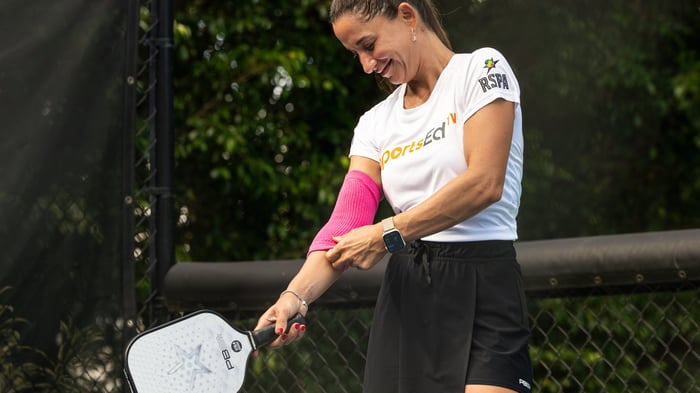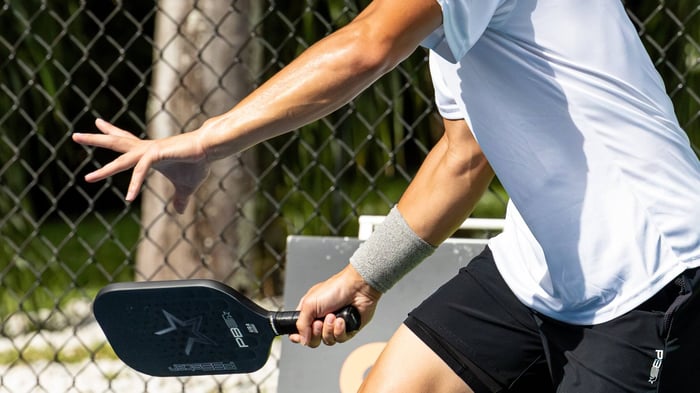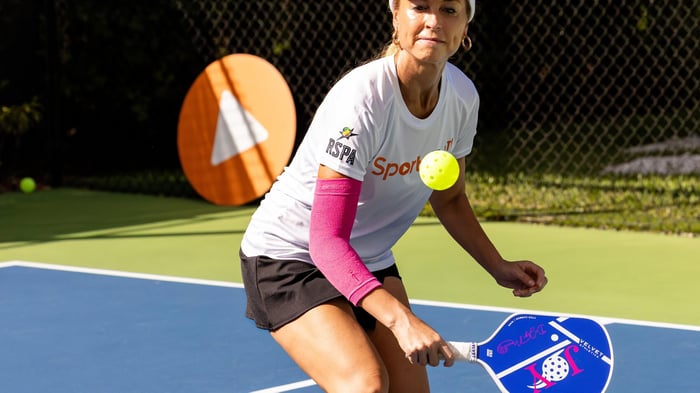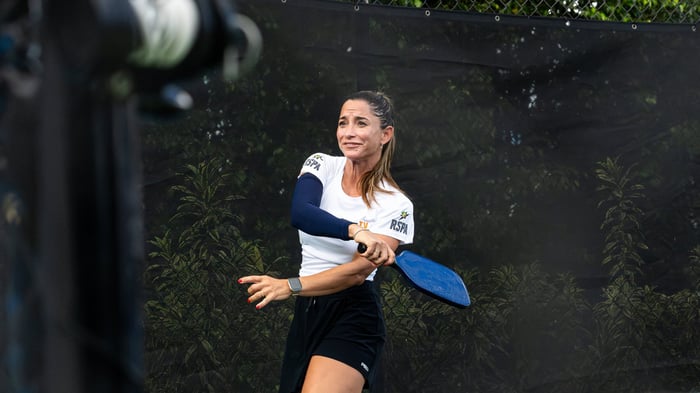Key takeaways:
Targeted pickleball drills tailored to your skill level are essential for consistent improvement, building muscle memory, and boosting confidence on the court.
Specific drills that focus on foundational skills, strategic gameplay, and competitive readiness benefit beginners, intermediate, and advanced players.
Practicing with the right gear enhances your performance, ensuring comfort, durability, and style during every training session and match.
No matter where you are in your pickleball journey, one thing is sure: the proper drills for your skill level make all the difference. Tailoring your training to your current abilities helps reinforce the skills you’ve already built while pushing you to the next level with confidence and clarity. Rather than guessing what to practice next, following a skill-specific roadmap keeps your development focused and efficient.
Whether you're mastering your first dink or refining your serve placement under pressure, your practice should evolve with your game. That’s why we’ve organized this guide to deliver the most effective drills for every play stage, from beginner to advanced. At PB5star, we’re committed to helping you train smarter, move better, and show up confidently every time you step on the court.
Why skill level matters in pickleball drills (and how to self-assess)
Selecting drills that align with your current skill level is not merely a cautious choice; it's a smart training strategy that leads to tangible improvements. Practicing drills designed for your skill level builds confidence through achievable challenges while avoiding frustration. Matching drills to your ability level allows you to master fundamentals, creating a solid foundation for advanced techniques.
Self-assessment doesn't require formal evaluation, just honest reflection on three key areas. First, consider your consistency: can you keep the ball in play for extended rallies? Next, evaluate your shot variety: do you rely on a few go-to shots, or can you execute various techniques confidently? Finally, assess your understanding of game rules and strategy.
Essential drills for beginners
Starting your pickleball journey with the proper foundation makes all the difference in your long-term development. The best pickleball drills for beginners focus on building instinctive reactions through consistent practice while developing the core skills you'll use in every match.
Strengthen footwork and court positioning first: Practice moving efficiently around the court while maintaining balance and a ready position. Good movement becomes second nature through practice.
Master the dink at the net: Practice soft, controlled shots just over the net with a partner, focusing on placement rather than power. This foundational drill develops the touch and precision needed for winning net battles in competitive matches.
Build groundstroke consistency from the baseline: Rally with a partner at a steady rhythm, gradually increasing speed as your control improves. These reliable foundation shots become your go-to weapons when applying pressure from the back court.
Develop quick reflexes with volley drills: Stand close to the net and practice rapid-fire volleys, keeping your feet light and paddle ready. These exercises sharpen your reaction time for those lightning-fast exchanges that decide close games.
Practice target accuracy with cone drills: Set targets around the court and aim for specific zones from different positions. This structured approach builds precision in placing shots strategically during match play.
Starting with the proper drills helps beginners build confidence, coordination, and consistency from day one. These foundational exercises develop the habits and muscle memory that support every future skill you’ll learn. By focusing on control, positioning, and purposeful repetition, you create a strong base that makes more advanced techniques easier to adopt.
Intermediate drills: Advancing consistency and strategy
Pickleball drills for intermediate players need to challenge both physical skills and mental game awareness. These drills bridge the gap between basic consistency and competitive strategy, preparing you for more dynamic match situations.
Master cross-court dinking patterns: Practice sustained cross-court dinks within the non-volley zone, focusing on placement and control while building patience.
Perfect your third-shot drop technique: Work on hitting soft, precise shots that land in the kitchen after the serve return.
Practice moving from back court to net: Work on transitioning from the baseline to the kitchen line while maintaining ball control.
Run defensive reset drills: Practice turning aggressive attacks into controlled dinks, developing the composure to neutralize opponents' power shots.
Use target-based solo practice: Place cones or markers on court zones and practice hitting specific areas when partners aren't available, sharpening your precision and shot selection skills independently.
At the intermediate level, it’s all about turning solid fundamentals into strategic execution. These drills push your control, decision-making, and court awareness, helping you thrive in faster-paced, more unpredictable rallies. You'll build the tools needed to dictate pace and respond confidently to pressure by focusing on transition movement, third-shot precision, and scenario-based play.
Advanced drills for competitive play: sharpening your edge
When you're ready to compete at the highest levels, your practice must match tournament play's intensity and precision. These advanced pickleball drills push beyond basic consistency to develop the lightning-fast reflexes, strategic thinking, and mental toughness that separate good players from great ones.
Lightning Volley Exchanges: Practice rapid-fire volleys at the net with a partner for 2-3 minute intervals, focusing on quick hands and minimal backswing. Start with controlled exchanges, then gradually increase pace while maintaining accuracy.
Defensive Reset Mastery: Work on defensive strategies that help you regain control during aggressive rallies. Practice hitting soft resets from difficult positions, targeting your opponent's backhand to neutralize their attack and create your offensive opportunities.
Solo Wall Training: Execute wall drills to maintain your competitive edge without a practice partner. Focus on quick volleys, backhand flicks, and reaction shots against a wall, maintaining proper form while increasing speed every 30 seconds.
Target Serving Under Tournament Pressure: Set specific targets in the service boxes and practice consistently hitting them during 10-serve sequences. This target serving approach improves precision when facing match point situations.
Execute Rapid-Fire Dinking Precision: Master rapid-fire dinking exercises that challenge your ability to maintain low trajectory shots while moving laterally for 5-minute rounds. This drill builds the hand-eye coordination needed for extended net battles.
These drills are designed to sharpen your instincts, elevate your precision, and condition your body and mind for the demands of competitive play. By simulating match pressure and refining advanced shot selection, you'll build the discipline and adaptability that wins games when it matters most.
How to progress between levels
Progressing in pickleball isn’t just about playing more; it’s about building the proper habits at the right time. Whether moving out of the beginner stage or pushing into high-level competition, knowing what to focus on helps you train smarter and track your growth. Here’s what to look for as you advance from one level to the next.
From beginner to intermediate
Rally control: You can steadily maintain rallies with forehands and backhands without frequent unforced errors.
Kitchen line awareness: You understand the importance of getting to the non-volley zone and can transition forward after your serve or return.
Basic shot execution: You can hit dinks, volleys, and groundstrokes with enough control to place them in safe zones intentionally.
From intermediate to advanced
Strategic shot placement: You can aim for specific court areas to apply pressure, not just keep the ball in play.
Third-shot drop reliability: You can execute soft, accurate third-shot drops in live gameplay to neutralize aggressive returns.
Controlled transitions: You move confidently from the baseline to the kitchen line, even under pressure, without sacrificing control.
Each level of pickleball builds on the last, but progress is less about perfection and more about consistency, control, and game sense. Use these milestones to measure your development and guide your training. Stay intentional in your drills, challenge yourself with purpose, and trust the process. With time and smart practice, you'll naturally level up your play.
Frequently asked questions (FAQs) about progressing with pickleball drills
Whether you're strategizing your next practice session or wondering if you're ready for more challenging training, these questions address the most common concerns about matching your approach to your goals. Smart players ask the right questions about choosing pickleball drills that accelerate their progress.
How do I know which pickleball drills match my skill level?
Your skill level is your training compass; it determines which exercises will challenge you appropriately without causing frustration or stagnation. Ask yourself: Can you consistently serve in bounds 8 out of 10 times, maintain a dinking rally for 20+ shots, and understand basic positioning rules? If yes, you're ready for intermediate challenges emphasizing shot placement and strategic gameplay, while advanced players need high-pressure scenarios that test speed, precision, and anticipation.
What are the best pickleball drills for beginners?
New players should prioritize foundational exercises that develop hand-eye coordination and basic control, such as wall practice for ground strokes and simple dinking patterns. These repetitive, low-pressure activities build the muscle memory for consistent play while establishing proper form. Starting with exercises that focus on contact point and paddle control creates the foundation for everything that comes next.
Which advanced pickleball drills help improve competitive play?
Competitive players thrive on exercises that simulate match pressure and demand split-second decision-making, such as rapid-fire volley exchanges and defensive reset sequences. Structured practice incorporating complex scenarios helps bridge the gap between recreational and tournament-level performance. The most effective advanced training challenges your speed, precision, and court awareness while preparing you for the mental demands of league competition.
How can pickleball drills help me progress from intermediate to advanced?
The transition requires exercises that blend technical skill with strategic thinking and mental toughness. Focus on training that forces quick transitions between offensive and defensive positions, simulates high-pressure scenarios, and develops your ability to read opponents' intentions. Consistent practice with increasingly challenging exercises builds the neuronal connections needed for faster reaction times and more intuitive gameplay.
Play better, look better: join the PB5star community
Improving your game isn’t just about logging hours on the court but making each session count. Choosing drills that match your current skill level helps you train purposefully, avoid unnecessary frustration, and build confidence through progress. When you practice with intention, even the most minor adjustments can lead to breakthroughs in your performance.
No matter where you start, there’s always room to grow, and the drills in this guide are designed to help you build a stronger, smarter, and more adaptable game at every stage. At PB5star, we’re here to support that growth with thoughtful training insights and premium apparel that helps players of all levels look, feel, and play their best.







